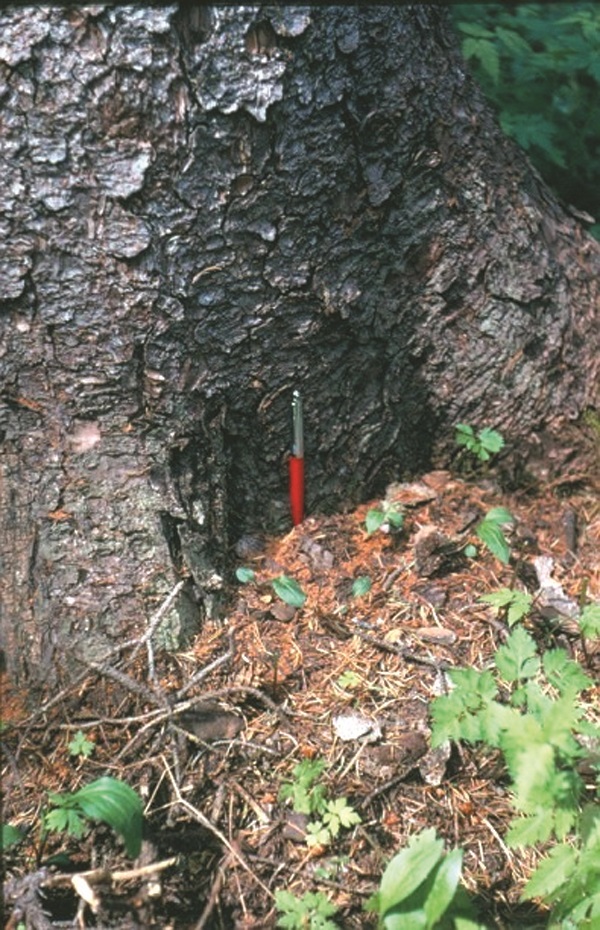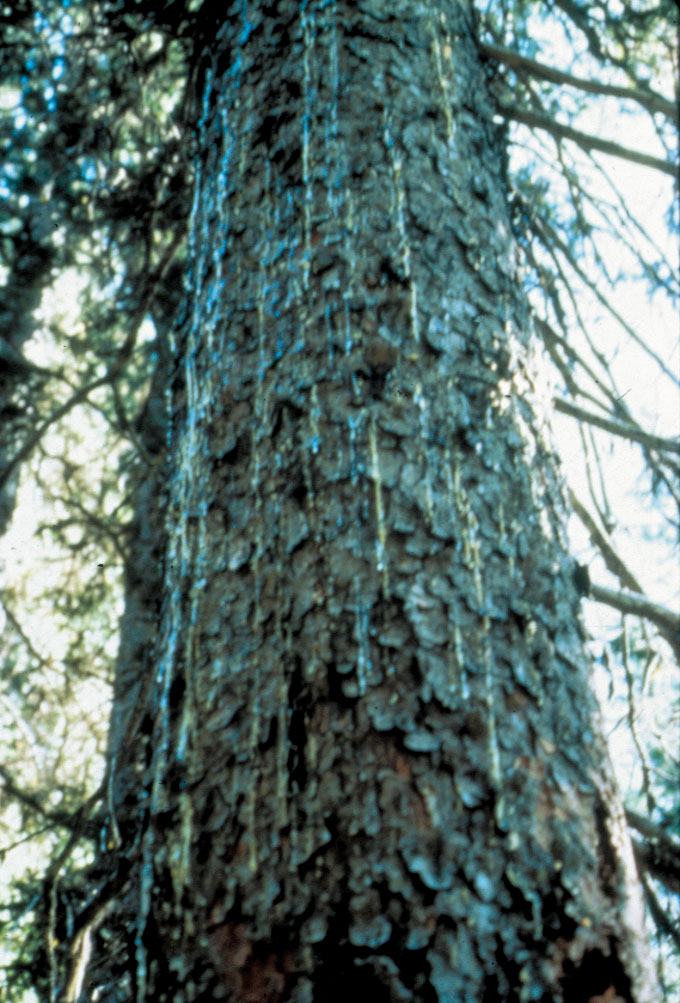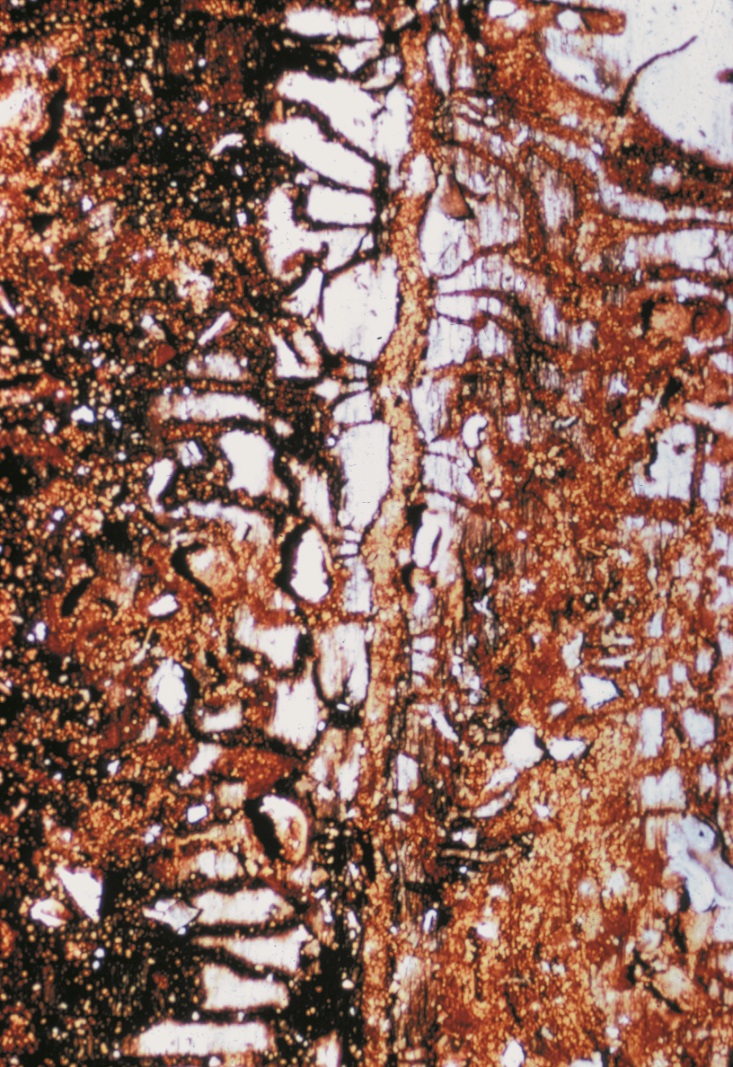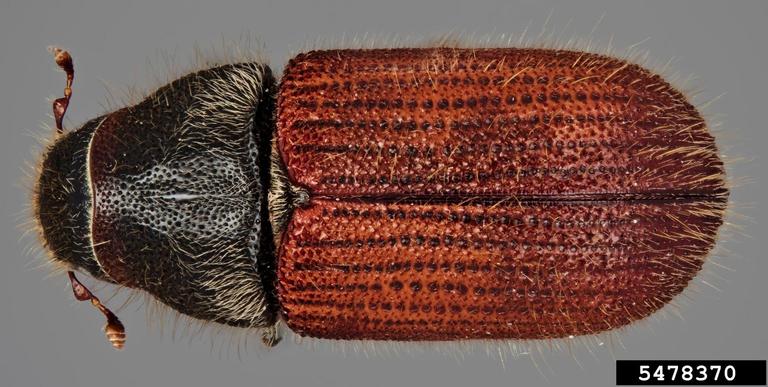Spruce Beetle
Dendroctonus rufipennis
Key Wildlife Value:
The spruce beetle creates spruce snags of various sizes, preferring to attack and kill large trees, but during outbreaks killing all sizes of trees down to small saplings. Snags tend to occur in a clustered pattern unless host trees have a scattered distribution. During outbreaks, high density snag patches may be created in certain forest types. Spruce beetle-killed trees provide good woodpecker foraging habitat. Canopy gaps form where groups of trees are killed. Low levels of spruce beetle-caused mortality may increase structural diversity and may sometimes increase plant species diversity. Trees killed by D. rufipennis contribute to levels of down wood when they break or fall over.
Distribution in Oregon and Washington:
Found throughout both states; more uncommon and less important west of the Cascades crest than on the Eastside. (See also Important Habitats and Outbreak Dynamics).
Hosts:
Engelmann spruce, Sitka spruce, Brewer spruce.
Diagnosis:
Reddish-brown boring dust in bark crevices and on the ground beneath the boles of standing or windthrown trees or logs is usually the most obvious sign of the presence of spruce beetles.




Larvae are white legless grubs with brown heads. Pupae are soft and creamy white, with body forms somewhat resembling adults. Adult beetles, which measure about 6 mm long and have a cylindrical shape, are dark brown to black with clubbed antennae and rounded posteriors.

Foliage discoloration and needle loss generally are not apparent until a year or more following attack. Infested spruce crowns do not become brightly colored like most other beetle-killed conifers. Instead they may fade slightly to a yellowish green the second summer following attack, but frequently still are green when the needles begin to drop.

Single trees may be killed by spruce beetle, but groups of trees are also frequently killed, especially during outbreaks.

Life History:
Spruce beetle populations in the western United States may complete their life cycle in 1 year on warm sites or may take up to 3 years in cooler locations. In Washington and Oregon, most spruce beetle populations are thought to have 2-year life cycles, although it is possible that populations having 1-year life cycles may occur in southwestern Oregon and coastal areas. Populations with 2-year life cycles have overlapping generations. There are four life stages: egg, larva, pupa, and adult. Adults emerge from May to July and colonize fresh host material. Spruce beetle flights begin when temperatures increase above 12.8° C to 16° C. Attacks begin in the lower bole area and may subsequently fill in higher on the middle and upper tree bole. Females initiate attacks and are soon joined by the males. After mating, females lay their eggs in small niches on the sides of the egg gallery, tending to cluster them in groups on alternate sides of the gallery. When egg laying is complete, some parent beetles reemerge and establish a second brood, usually during August through October. After hatching, groups of larvae feed “en masse” in common chambers, moving horizontally away from the egg gallery, until they are about one-third grown, when they begin individual mines. The feeding larvae frequently cross and recross the mines of other larvae as they develop. They usually spend their first winter in the larval stage, pupating and transforming to adults the following summer in open cells at the ends of the larval galleries. The new adults must go through another winter season before they are able to attack new trees or reproduce. They pass the second winter either in their pupal cells or in chambers in the root collar bark at the bases of infested trees.
Important Habitats and Outbreak Dynamics:
Spruce beetle is most prevalent east of the Cascades Mountains crest in stands dominated by Engelmann spruce. Even though Sitka spruce is abundant in the coastal regions of Oregon and Washington, spruce beetle outbreaks in those areas are rare. Windthrown trees provide important habitat, and are generally preferred for colonization by spruce beetles over standing trees. Freshly cut logs, stumps, and slash may also provide favorable habitat. On down trees and other woody material, shaded locations on boles and bole undersides are preferred over sun-exposed areas. Trees with tomentosus root disease (caused by Onnia tomentosa) probably help to maintain spruce beetle when population levels are low, but spruce beetles do not appear to be specifically attracted to trees with this disease. However, spruce infected with root disease pathogens that kill trees more quickly than O. tomentosa, such as Phellinidium sulphurascens or Armillaria solidipes, are likely to prove attractive to spruce beetles.
Spruce trees generally have a shallow rooting habit, often growing on wet sites, and are naturally prone to windthrow. Most major spruce beetle epidemics have developed following significant windthrow events, especially those resulting in a widespread, scattered distribution of down trees as opposed to a concentrated area of flattened forest. Spruce beetle populations can build up rapidly in down material because survival rates are high, and if no additional down material is available when the inhabiting broods emerge, they begin to attack standing trees. During major spruce beetle outbreaks, standing trees of all ages and diameters except for seedlings and small saplings may be attacked. Larger diameter trees (≥ 45.7 cm, or 18 in) usually are attacked first, and nearby trees of any size are also killed, due to the aggregating effects of beetle pheromones. Once begun, outbreaks may continue for several years until most of the large spruce trees in a region are killed. Residual stands may be reset to an earlier developmental phase when surviving young spruce predominate, or, when true fir predominates in the surviving stand, natural succession to shade tolerant species may be accelerated.
Local infestations have been triggered by activities associated with logging operations that resulted in the creation and retention of suitable host material on susceptible forest sites. Local outbreaks are likely to result in elevated spruce mortality in a more restricted area, usually with less severe stand effects.
Thresholds for spruce beetle risk specific to Oregon and Washington have never been developed, but considerable work has been done in other regions, including the Rocky Mountains and Alaska. It is reasonable to expect that general patterns of risk in the Pacific Northwest are similar to those in other western regions. The only consistent characteristic indicating susceptibility in other regions is the diameter of standing trees. In Alaska, the determination of high susceptibility for a spruce stand is based on average diameter (≥ 30 cm, or 12 in), stand age (old growth), stand condition (less than average growth rate in the preceding 5 years), and proportion of white spruce (≥ 70 percent), while in the Rocky Mountain area, high susceptibility is based on geographic location (well drained creek bottom), average diameter (≥ 41 cm, or 16 in), basal area (> 14 m2 per 0.4 ha), and proportion of spruce (> 65 percent). In Arizona, mortality caused by spruce beetle has been documented as being highest in areas with the largest trees and highest basal areas. From these criteria, it is possible to speculate that, like many other Dendroctonus beetles, tree size (representing quality and abundance of habitat) and host vigor (indicating resistance to attack), play important roles in the dynamics of spruce beetle colonization and reproduction when populations attain high levels.
Opportunities for Manipulation to Increase Wildlife Habitat:
Under certain circumstances it may be possible to create snags in dead wood deficient areas using spruce beetle attractant pheromones, but methodology and guidelines have not been developed yet for this use. Pheromones present some advantages for over mechanical methods for creating snags, such as topping or girdling, in that they are less expensive, safer to administer, and mimic a natural process. Snags created using beetle attractant pheromones would provide good foraging habitat for woodpeckers.
It also may be possible, in some areas and under certain situations, to create snags by creating, placing, or retaining freshly cut spruce material, logs or trees near standing spruce trees (see photo).

Potential Adverse Effects:
Spruce beetle outbreaks may result in significant modification of existing spruce-dominated stands by killing all of the large trees, reducing overall tree density and cover, and altering the species composition to less desirable species.

How to Minimize the Risk of Adverse Effects:
Risk of adverse effects from spruce beetle can be minimized by encouraging moderate to vigorous growth rates in high-risk stands by regulating tree densities, and, where suitable alternative tree species are available, by encouraging the growth of a mixture of tree species.
Prompt removal of windthrown trees, breakage, and log decks before they are colonized or before broods emerge (the second spring following the initial attack) will help to prevent or reduce the mortality of adjacent trees (e.g. for a windstorm event that occurs in January, 2016, removal of infested material would be completed prior to brood emergence and flight in spring, 2018). Logs that are limbed, lying in contact with the ground, and exposed to full sunlight generally pose little risk.
Other suppression methods, used once spruce beetles have already infested standing trees and down material, include removal of infested and susceptible spruce trees, the employment of “trap trees,” which are typically created by falling or baiting with attractant pheromones large spruce trees and then removing them after they become saturated with colonizing beetles and before the inhabiting brood emerges, and the use of insecticides applied to the boles of trees. Most of these methods are practical only for high value trees on developed or other special sites.
Although MCH, the Douglas-fir beetle’s anti-aggregating pheromone, also elicits some response by spruce beetle, previous efforts to use MCH to protect residual Engelmann spruce trees following windthrow events have yielded inconsistent and unsatisfactory results. Ongoing research of alternative semiocheimical repellents may provide effective behavioral management tools in the future
References
Goheen, E.M. and E.A. Willhite. 2006. Field guide to common diseases and insect pests of Oregon and Washington conifers. USDA Forest Service, Pacific Northwest Region, Portland, OR. R6-NR-FID-PR-01-06. 335 pp. http://www.biodiversitylibrary.org/bibliography/80321#/summary
Holsten, E.H., and J.S. Hard. 2002. Dispersal flight and attack of the spruce beetle, Dendroctonus rufipennis, in south-central Alaska. USDA Forest Service, Pacific Northwest Research Station, Portland, OR. Research Paper PNW-RP-536. 13 pp.
Holsten, E.H., R.W. Their, and A.S. Munson, and K.E. Gibson. 1999. The spruce beetle. Forest Insect and Disease Leaflet 127 (revised). USDA Forest Service, Washington, D.C. 12 pp.
Lewis, K.J., and B.S. Lindgren. 2002. Relationship between spruce beetle and tomentosus root disease: two natural disturbance agents of spruce. Can. J. For. Res. 32:31-37.
Schmid, J.M., and R.H. Frye. 1977. Spruce beetle in the Rockies. USDA Forest Service, Rocky Mountain Forest and Range Exper. Sta., Ft. Collins, CO, Gen. Tech. Rep. GTR-RM-49. 38 pp.
Schmid, J.M., and T.E. Hinds. 1974. Development of spruce-fir stands following spruce beetle outbreaks. USDA Forest Service, Rocky Mountain Forest and Range Exper. Sta. Ft. Collins, CO, Research Paper RM-131. 13 pp.